
1) Natural geography
|
Area > Comparative to US places
|
||
|
Capital city with population |
Djibouti - 395,000 |
|
|
Forested Land |
0.3% |
[187th of 193] |
|
Geographic coordinates |
11 30 N, 43 00 E |
|
|
highest towns > Town/City |
Airolaf |
|
|
land border lengths > D-F > Number of neighbours |
3 |
[5th of 14] |
|
land border lengths > D-F > Total Borders |
516 km |
[11th of 14] |
|
Largest city
|
||
|
Largest city population |
493,000 |
[116th of 174] |
|
Largest city with population |
Djibouti - 395,000 |
|
|
northernmost point > Latitude |
12°43'N |
|
|
Population density |
20.36 people per sqkm |
[182nd of 256] |
|
Population density > people per sq. km |
34.21 people/m² |
[148th of 204] |
|
Precipitation |
163 mm |
[89th of 95] |
|
Rural population density > rural population per sq. km of arable land |
11,487.87 people/km² of arable lan |
[1st of 188] |
|
Surface area > sq. km |
23,200 km² |
[146th of 206] |
|
tallest mountains > Mountain |
Moussa Ali |
|
SOURCES All
CIA World
Factbooks
18 December 2003 to 18 December 2008; United Nations
World
Statistics Pocketbook
and
Statistical
Yearbook
, City Population
, CIA World
Factbook, World Gazetteer , Official government websites.; FAO; Wikipedia List of
highest towns by country ; Wikipedia List of land
border lengths
; United Nations
World
Statistics Pocketbook
and
Statistical
Yearbook ; Wikipedia;
List of countries by northernmost point
;
Heal The World
Foundation.
; World
Development Indicators database ; Wikipedia; List
of tallest mountains by country
ALTERNATIVE NAMES Djibouti, Republic of Djibouti,
dijbouti
Environment
|
Adjusted savings carbon dioxide damage > % of GNI |
0.36 % of GNI |
[91st of 179] |
|
CO2 Emissions |
388 |
[154th of 178] |
|
CO2 emissions > kg per 2000 PPP $ of GDP |
0.27 kg/PPP$ |
[98th of 170] |
|
CO2 emissions > kt |
366.3 kt |
[172nd of 195] |
|
CPIA policy and institutions for environmental sustainability rating |
3 |
[45th of 75] |
|
Forest area > % of land area |
0.26 % of land area |
[191st of 195] |
|
Forest area > sq. km |
60 km² |
[182nd of 195] |
|
Freshwater withdrawal |
0.02 |
[122nd of 124] |
|
Freshwater withdrawal > Agricultural |
16% |
[119th of 124] |
|
Freshwater withdrawal > Domestic |
84% |
[1st of 124] |
|
Freshwater withdrawal > Industrial |
0% |
[119th of 124] |
|
Groundwater withdrawals |
0 |
[86th of 188] |
|
PM10, country level > micrograms per cubic meter |
48.31 mcg/m³ |
[64th of 185] |
|
Pollution > Carbon dioxide 1999 |
105 |
[164th of 199] |
|
Protected area |
0.2 |
[142nd of 147] |
|
Threatened species |
8 |
[137th of 158] |
|
Threatened species > Mammal |
6 |
[112nd of 160] |
|
Total renewable water resources |
0.3 cu km |
[27th of 31] |
SOURCES World Development
Indicators database
; World Resources Institute. 2003. Carbon Emissions from
energy use and cement manufacturing, 1850 to 2000. Available on-line through the
Climate Analysis Indicators Tool
(CAIT) at
Washington, DC World Resources Institute; All CIA World
Factbooks
18 December 2003 to 18 December 2008; ; Gregg Marland, Tom Boden,
and Bob Andres, University of North Dakota, via
net publication
;
Jacaranda Atlas
; United Nations
World
Statistics Pocketbook
and
Statistical
Yearbook
ALTERNATIVE NAMES Djibouti,
Republic of Djibouti, dijbouti
2) Human geography
Age distribution
Djibouti Population Pyramid for 1990
Age and sex distribution for the year 1990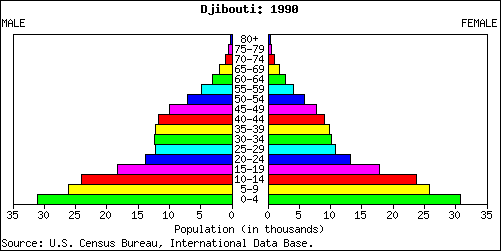
Djibouti Population Pyramid for 1995
Age and sex distribution for the year 1995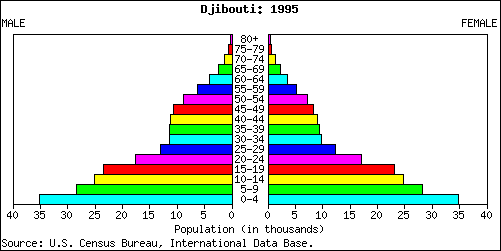
Djibouti Population Pyramid for 2000
Age and sex distribution for the year 2000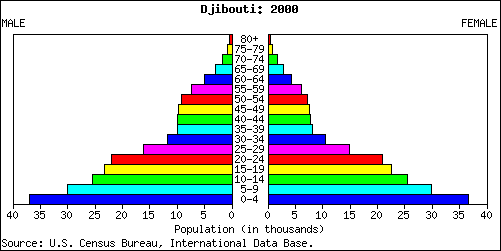
Djibouti Population Pyramid for 2003
Age and sex distribution for the year 2003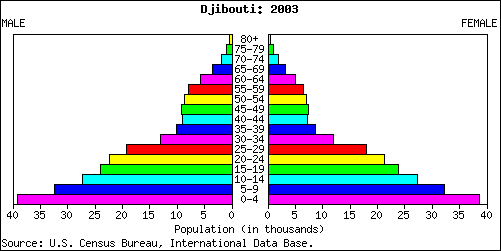
Djibouti Population Pyramid for 2005
Age and sex distribution for the year 2005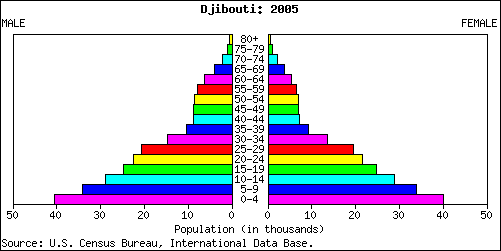
Djibouti Population Pyramid for 2010
Age and sex distribution for the year 2010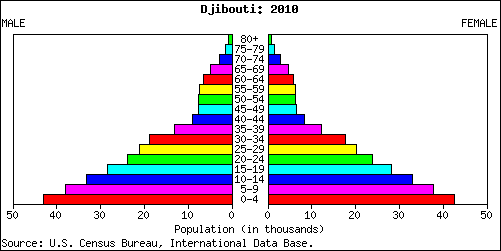
Djibouti Population Pyramid for 2020
Predicted age and sex distribution for the year 2020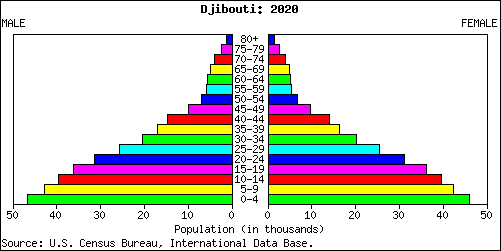
Djibouti Population Pyramid for 2050
Predicted age and sex distribution for the year 2050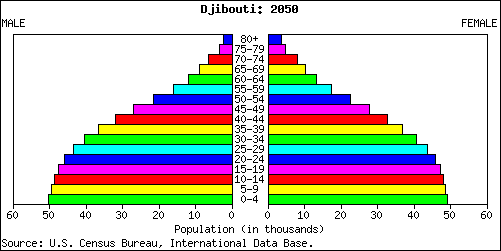
Source US Census
Bureau July 17, 2003
Labor
| Firing cost > weeks of wages | 56.3 weeks of wages | [52nd of 164] |
| force participation rate, female > % of female population ages 15-64 | 54.76 % | [113rd of 184] |
| force participation rate, total > % of total population ages 15-64 | 69.29 % | [98th of 184] |
| force, female > % of total labor force | 39.34 % | [119th of 184] |
| force, total | 314,646.3 | [156th of 184] |
| Parental leave > Paid maternity leave | 14 weeks | |
|
Parental leave > Paid paternity leave
10 days family-related leave |
||
| Right to Organise and Collective Bargaining Convention > Ratifications > Date | August 3, 1978 | |
| Rigidity of employment index | 46 | [59th of 166] |
| Unemployment with secondary education, female > % of female unemployment | 27.1 % | [21st of 71] |
| Unemployment with secondary education, male > % of male unemployment | 23.7 % | [17th of 71] |
| Unemployment with tertiary education > % of total unemployment | 0.3 % | [37th of 77] |
| Unemployment with tertiary education, female > % of female unemployment | 0.5 % | [32nd of 71] |
| Unemployment with tertiary education, male > % of male unemployment | 0.3 % | [33rd of 71] |
| Unemployment, female > % of female labor force | 46.7 % | [1st of 95] |
| Unemployment, male > % of male labor force | 41.9 % | [1st of 95] |
| Unemployment, total > % of total labor force | 43.5 % | [1st of 101] |
| Workers' remittances and compensation of employees, paid > US$ | 18,000,000 $ | [71st of 149] |
| Workers' remittances and compensation of employees, received > US$ | 12,000,000 $ | [108th of 156] |
| Workers' remittances, receipts > BoP, current US$ | 1,024,077 BoP $ | [79th of 115] |
SOURCES World Development Indicators database ; Wikipedia Parental leave ; Wikipedia Right to Organise and Collective Bargaining Convention, 1949
ALTERNATIVE NAMES Djibouti, Republic of Djibouti, dijbouti
People
|
Age dependency ratio > dependents to working-age population |
0.8 |
[39th of 185] |
|
Age structure > 0-14 years |
43.3 |
[29th of 226] |
|
Age structure > 15-64 years |
53.5 |
[199th of 226] |
|
Percentage living in rural areas. |
16% |
[161st of 193] |
|
Percentage living in urban areas |
84% |
[38th of 199] |
|
Population > CIA Factbook |
506,221 |
[167th of 240] |
|
Population ages 0-14 > % of total |
41.48 % |
[36th of 185] |
|
Population growth > annual % |
1.78 annual % |
[66th of 195] |
|
Rural population |
110,237.8 |
[165th of 193] |
|
Sex ratio > 15-64 years |
1.09 |
[18th of 223] |
|
Sex ratio > sex ratios > total |
1.05 |
[35th of 215] |
|
Total Population |
486,530 |
[166th of 227] |
|
Total Population > Female |
237,468 |
[167th of 227] |
|
Total Population > Male |
249,062 |
[166th of 227] |
|
Urban population |
682,840.2 |
[149th of 195] |
|
Urban population growth > annual % |
2.43 annual % |
[79th of 195] |
|
Urbanization |
84 |
[34th of 204] |
|
Urbanization in 2015 |
86.9% |
[27th of 164] |
|
Women > Adult literacy rate females as a % of males |
72 |
[109th of 144] |
|
Women > Life expectancy females as a % of males |
104 |
[129th of 173] |
SOURCES World
Development Indicators database
;
CIA World Factbook
,
28 July 2005; Population Division of the United Nations Secretariat, World
Urbanization Prospects The 2003 Revision, Data Tables and Highlights. Estimates
and projections of urban and rural populations are made by the Population
Division of the United Nations Secretariat and published every two years. These
estimates and projections are based on national census or survey data that have
been evaluated and, whenever necessary, adjusted for deficiencies and
inconsistencies; All
CIA World
Factbooks
18 December 2003 to 18 December 2008; Wikipedia
Sex ratio
;
U.S. Census Bureau,
Population Division, International Programs Center Spanish Statistical Institute
; Population
Division of the United Nations Secretariat, World Urbanization Prospects The
2001 Revision, Data Tables and Highlights (ESA/P/WP.173, 20 March 2002); UN
(United Nations). 2002. World Urbanization Prospects The 2001 Revision.
Department of Economic and Social Affairs, Population Division. New York;
UNICEF
ALTERNATIVE NAMES
Djibouti, Republic of Djibouti, dijbouti
Mortality
|
Death rate, crude > per 1,000 people |
12.24 per 1,000 people |
[47th of 195] |
|
rate, adult, female > per 1,000 female adults |
354.85 per 1,000 female adults |
[32nd of 185] |
|
rate, adult, male > per 1,000 male adults |
383.47 per 1,000 male adults |
[36th of 185] |
|
rate, infant > per 1,000 live births |
88 per 1,000 live births |
[24th of 187] |
|
rate, under-5 > per 1,000 |
133 per 1,000 |
[26th of 187] |
SOURCES World Development
Indicators database
ALTERNATIVE NAMES Djibouti, Republic of Djibouti,
dijbouti
Immigration
|
immigrant population > Immigrants as percentage of state population |
2.522 |
[109th of 195] |
|
immigrant population > Number of immigrants |
20,000 |
[158th of 195] |
|
immigrant population > Percentage of total number of immigrants in the world |
>0.1% |
|
|
Net migration rate |
0 migrant(s)/1,000 populati |
[121st of 225] |
|
Refugees > Convention on refugees |
9 Aug 1977 d |
|
|
Refugees > Outflow |
2,000 |
[53rd of 76] |
|
Refugees > US applications |
7 |
[44th of 64] |
|
Refugees and internally displaced persons > Refugees (country of origin) |
8,642 (Somalia) |
|
|
US visa lottery winners |
24 US visa lottery winners |
[114th of 178] |
SOURCES Wikipedia;
List of countries by immigrant population
; All
CIA World
Factbooks
18 December 2003 to 18 December 2008; United Nations Treaty
Collection; UNHCR (United Nations High Commissioner for Refugees). 2002.
Correspondence on refugees and internally displaced persons. February. Geneva.;
United States Citizenship and Immigration
Services
; US Department of State Bureau of Consular Affairs
ALTERNATIVE NAMES Djibouti, Republic of Djibouti, dijbouti